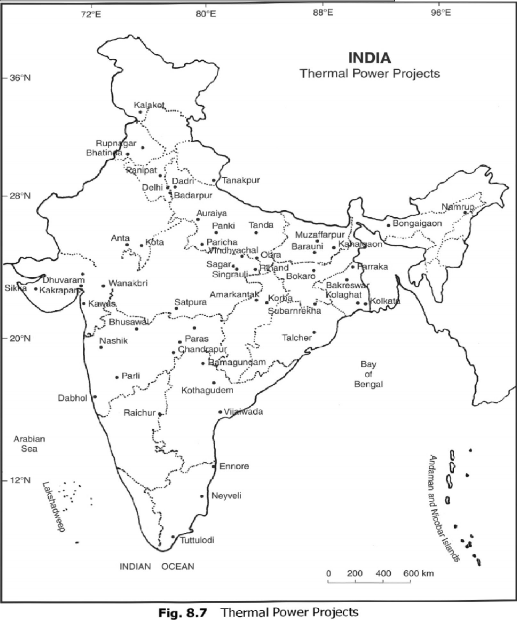Thermal Electricity
Thermal electricity is produced with the help of coal, petroleum, and natural gas. About 65 per cent of the total electricity produced is thermal in character. The main advantages of thermal electricity are as under:
(i) It can be generated in the areas not suitable for the generahon of hydro-electricity.
(ii) Coal, diesel and natural gas can be transported to the areas of isolation and relative isolation.
(iii) It can be generated even when the weather is adverse.
(iv) The gestation period of the thermal power stations is short.
The production of thermal energy is, however, not eco friendly as the release of carbon dioxide pollutes the atmosphere. Moreover, it consumes the valuable exhaustible resources like coal, petroleum and natural gas.
Some of the important thermal power stations of India have been given in Table 8.10.



Table 8.10 India—Thermal Power Stations
States | Thermal Power Stations with Installed Capacity in MW | |
1. Andhra Pradesh | Bhadrachalam, Kothagudam (680), Manuguru, Nellore (300), Ramagudam (200), Vijayawada (420) | |
2. Assam | Bongaigaon (120), Chandarpur (100), Namrup (112) | |
3. Bihar | Barauni (255), Kahalgaon, DVC (780), Durgapur (285), 1 | |
4. Chhattisgarh | Korba (750) | |
5. Delhi | Badarpur (720), Indraprastha (285), Rajghat (350) | |
6. Gujarat | Ahmadabad (180), Banas, Dhuvaram (534), Gandhinagar (240), Kachchh, Kandla, Mahuva, Porbandar, Sabarmati (110), Shahpur, Sikka, Ukai (640), Utaran (200), Wankbori, | |
7. Haryana | Faridabad (180), Panipat (220), Yamuna Nagar (150) | |
8. Jammu & Kashmir | Kalakot | |
9. Jharkhand | Bokaro (248), Chandrapur (780), Subarnrekha | |
10. Madhya Pradesh | Amarkantak (3000), Salpura (1142), Singrauli, Vindhyachal (1260) | |
11. Maharashtra | ||
Ballarshah (500), Bhusaval(485), Chandrapur (210), Chola (95), Dhobal | ||
(350), Khapar-Kheda (250), Koradi (1100), Nasik (810), Paras (95), Parli (240), Trombay (838), Ujjaini, Uran (240) | ||
12.Manipur | Loktak (Imphal) | |
13. Punjab | Bhatinda (440), Rupnagar | |
14. Rajasthan | Anta, Banswara, Kota (240), Palana, Sawai Madhopur. | |
15. Odisha | Balimela, Talcher (470) | |
16. Tamil Nadu | Ennore (450), Mcttur, Neyveli (2300), Tuticorin (630) | |
17. Uttar Pradesh | Bahraich, Dorighat, Gorakhpur, Harduaganj (215),Jawaharpur, Kanpur (325), Mau, Moradabad, Obra (450), Panki (345), Parichha (240), (565), |
Tundla. | |
18. We st Bengal | Birbhum, Bundel (540), Durgapur (285), Farakka (1600), Gauripur (350), Kalaghat, Kolkata (250), Murshidabad, Titagarh, Santaldih (480) |
It may be seen from Table 8.10 that the distribution of thermal power stations is highly unequal. Most of them, however, have been located near the source of inferior coal or lignite mining centres. The state of Maharashtra ranks first in the production of thermal power, followed by Uttar Pradesh, Gujarat, and West Bengal. The rank of Madhya Pradesh (including Chhattisgarh) and Tamil Nadu are sixth and seventh respectively. Arunachal Pradesh, Goa, Himachal Pradesh, Kerala, Meghalaya, Mizoram, Nagaland, Sikkim, Tripura and Uttarakhand are the states which are devoid of the production of thermal electricity. On the zonal basis, the western zone is the largest producer of thermal energy, followed by the northern zone, eastern and southern zones. Thermal power stations have been installed at Raichur (Karnataka) and Loktak (Manipur).
The contribution of National Thermal Power Corporation is quite significant in the generation of thermal energy. The NTPC thermal power stations in the country have been given in Table 8.11.
Table 8.11 India—Major Thermal Power Stations
Projects/Stat io ns | Installed Capacity (MW) |
1. Badarpur | 720 |
2. Farakka (West Bengal) | 1600 |
3. Kahalgaon (Bihar) | 840 |
4. Korba (Chhattisgarh) | 2100 |
5. National Capital Thermal Power Plant Dadri (U.P.) | 840 |
6. Ramagundum (Andhra Pradesh) | 2100 |
7. Rihand /Obra (Uttar Pradesh) | 1000 |
8. Singrauli (Madhya Pradesh) | 2000 |
9. Talcher (Odisha) | 720 |
10. Unchahar (Uttar Pradesh) | 720 |
11. Vindhyachal (Madhya Pradesh) | 1260 |
12. Gas Based Projects: | |
(i) Anta (Rajasthan) | 430 |
(ii) Auraiya (Uttar Pradesh) | 600 |
(iii) Kawas (Gujarat) | 600 |
Total | 15530 |

